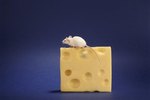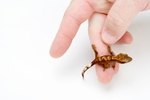
Two chinchilla species exist: Chinchilla lanigera and Chinchilla brevicaudata. The latter of the two is rare -- possibly even extinct -- so any pet you keep in your house will certainly be a Chinchilla lanigera. These rodents originate from mountainous regions of northern Chile, where they live in large groups. As social creatures, they need company, but you should carefully consider the kind of pets they live with.
Other Chinchillas
In the wild, chinchillas live in colonies of up to 100 members of their own species. They're highly social creatures, so it's imperative that you keep them in groups. Kept alone, they're likely to suffer and develop abnormal behaviors. You can either keep them in same-sex groups or in a male-female pair. Keep a pair only if you're willing to have the male neutered to avoid any unwanted new arrivals.
Other Pets in Their Cage
Chinchillas have specific needs that differ from any other kinds of creatures, so they should never share a cage with a different species. Even if they seem to get along under your supervision, you're asking for trouble. Disregarding any behavioral incompatibilities, chinchillas' dust baths are likely to cause respiratory problems in other small animals. Rabbits' droppings harbor bacteria that can be fatal to chinchillas, so never allow the two to mix.
Other Pets in the House
Because chinchillas are prey animals, keeping them in the same house as predators -- such as dogs and cats -- can be problematic, although it's not impossible. Ensure that your chinchillas are kept away from other animals during the daytime. They're nocturnal creatures, so they need peace and quiet during daylight hours. Never allow larger pets to play with your chinchillas. Even if the other animal means well, they could injure your chinchillas during play.
Housing Your Chinchillas
Provide your chinchillas with a cage of appropriate size. The minimum cage size for a pair is 30 inches wide, 30 inches deep and 36 inches tall. A larger cage is preferable. Ensure there are no exposed wire mesh floors or platforms, as these can hurt and damage their feet. Keep them in a room away from other pets. Their rooms must be climate-controlled. Exposure to temperatures over 80 degrees Fahrenheit can precipitate heatstroke, which is potentially fatal.
References
Photo Credits
-
Creatas/Creatas/Getty Images



